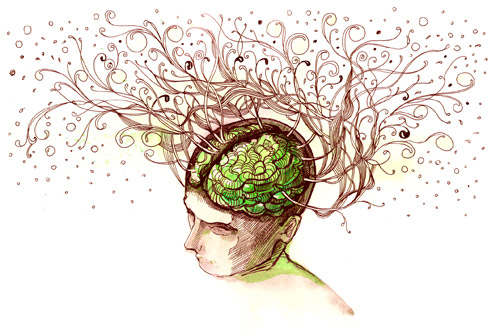By David Dubin, M.D.
After Einstein’s death, his brain was preserved for future study. Scientists were naturally curious to see how the brain of this genius compared with the brain of a person of ordinary intelligence. Would there be an abundance of neurons (grey matter) or some unusual wiring of the neurons that distinguished his brain? When the brain was dissected, however, the only difference was that the numbers of cells that were not neurons (white matter) was dramatically increased. It is also true that, from evolutionary point of view, as brains became larger and “smarter”, what increased was not the percentage of neurons but of white matter. What does this mean?
When most of us–scientists and lay people alike—imagine the brain, we think of neurons, those cells carrying information in the form of electrical impulses. Neurons are ‘brains of the brain’, so to speak, and the rest of the cells were thought to be there only for support. But neurons account for only 15 percent of the brain, while these so-called ‘support’ cells occupy 85 percent.
The group name for white matter cells, glia—derived from the world ‘glue’—reflects their lowly status. First seen clearly by anatomists in the late 1800’s, Glia were initially thought to be little more than structural support for neurons, because, like scaffolding, glial cells literally hold neurons in place.
It was later found that glia can speed transmission of electrical signals and also deliver energy to neurons and remove neuronal waste products. While appearing to be a little more interesting than originally thought, glia still seemed about as sexy as wire insulation, food delivery and waste management devices.
Unlike neurons, there is no electrical activity within glia to send messages and information. It was therefore assumed that glia were deaf and dumb, incapable of communicating with either neurons or other glia, and therefore not particularly compelling as a focus of research. A good analogue would be the under-appreciated dark matter in astronomy. Dark matter is undetectable because it emits no electromagnetic radiation as the matter in the “visible” universe does. The existence of dark matter was eventually inferred from its gravitational effects on visible matter. While we had believed that the visible universe is the universe, the ordinary matter of our visible universe accounts for less than five percent of the total; dark matter accounts for more than 20 percent.
Today, the pace of knowledge about glia has begun to accelerate, as outlined in an exciting new book, The Other Brain, by Dr. R. Douglas Fieldsi (the title refers to the 85 percent of the brain that is glial). Fields is a neuroscientist specializing in glial cell research, and the information in his book is so new that it isn’t found in standard medical textbooks. Two review articles in the May, 2010 issue of the research journal Nature Neuroscience attest to how much still needs to be learned, and how potentially revolutionary are the implications.
So, are glial cells really dumb as a doorknob? First, we are just now learning that glial cells do communicate, not through synapses but through “gap junctions”. These gap junctions are protein channels connecting one cell to another, like a spaceship docking at the mother station. Glia can pass messages among themselves by using calcium as a chemical messenger instead of sending an electric signal as neurons do. In his research, Fields showed that after a 15-second delay, changes in response to a neuronal firing were seen in the surrounding glial cells. As Fields puts it, glial cells are “listening in” on what neurons are doing, something virtually no one in neuroscience thought possible.
Contrary to all established dogma, it is now known that glia not only communicate directly from one cell to an adjacent one, but also with cells very far away. Glia are even able to “jump” over barriers like a ping pong ball going over a net. And whereas neurons transmit their signals in linear lines, like telephone wires, glia communicate, as Fields puts it, by “broadcasting signals widely, like cell phones.”
Glia are also critical to the growth of neurons. Neuron cells grown in the lab without accompanying glial cells were found to have many fewer synapses than neurons grown with glial cells. Glia seem to play a central role in the number of synapses a neuron develops.
Contrary to what scientists thought, glia also have neurotransmitters; in fact, the same ones that neurons do. And there are receptors for these neurotransmitters both inside and on the outer surface of glial cells. Glial cells have receptors for glutamate, the principal stimulating neurotransmitter in the cortex, and GABA, which acts as a “brake” to calm down neurons. In other words, glia can excite or depress neurons and stimulate or calm the brain, just like medications.
And, unlike neurons, glia can move. They have enormous cellular “fingers” like the elastic Mr. Fantastic of comic book fame, and can move between and on neurons. This constantly changes the circuitry of the brain. These glial fingers also form around synapses. They secrete substances that remodel tissue or stimulate neuron growth during development and repair of the brain making it likely that they function in a similar role during learning in the healthy brain.
Glia repair injury, defend against disease, nurse neurons back to health and act as guide dogs for the re-growth of injured nerve fibers. Glia detect and react to bacteria and viruses, “gobble up” pathogens and release toxic chemicals to kill bacteria. And new research suggests that immature glial cells can act like stem cells and mature glia can stimulate stem cells dormant in the adult brain to form replacement neurons and glia. This could have implications for repair of the nervous system, including new possibilities for treating spinal cord injuries.
This is about as far removed from mere insulation, food delivery and waste management services as can be imagined. Glia are a lot smarter than we thought they were. A 2005 study shows a correlation between organization of fibers made of glial cells and IQ. Finding a greater proportion of glial cells in Einstein’s brain is not so surprising after all.
We still know very little about glia—even the basics such as how many kinds of glial cells there are and what they look like in detail. Their discovery, however, broadens our appreciation of the complexity of the brain. The brain, with its 100 billion neurons and an average of 10,000 synapses per neuron, has more potential connections than the atoms of our galaxy!
We don’t know yet if diet, exercise, supplements and other factors affect glial cells. However, the implications for health and illness—seizures, infections, cancer, addictions, mental illness and diseases such as Parkinson’s and multiple sclerosis may be far-reaching and profound.
As Fields says near the end of his book, “Here are cells that can build the brain of a fetus, direct the connection of its growing axons to wire up the nervous system, repair it after it is injured, sense impulses crackling through axons and hear synapses speaking, control the signals neurons use to communicate with one another at synapses, provide the energy source and substrates for neurotransmitters to neurons, couple large areas of synapses and neurons into functional groups, integrate and propagate the information they receive from neurons through their own private network, release neurotoxic or neuroprotective factors, plug and unplug synapses, move themselves in and out of the synaptic cleft, give birth to new neurons, communicate with the vascular and immune systems, insulate the neuronal lines of communication, and control the speed of impulse traffic through them. And some people ask, ‘Could these cells have anything to do with higher brain function?’ How could they possibly not?”








